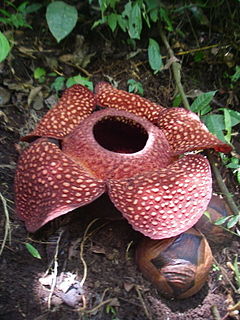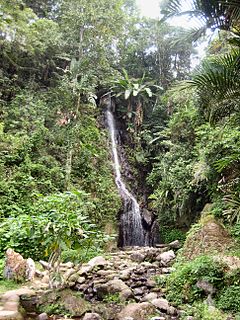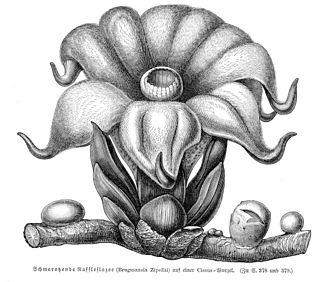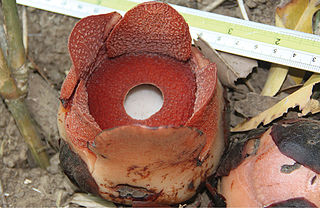
Rafflesia is a genus of parasitic flowering plants in the family Rafflesiaceae. The species have enormous flowers, the buds rising from the ground or directly from the lower stems of their host plants; one species has the largest flowers in the world. The genus contains approximately 28 species, all found in Southeast Asia, mainly in Indonesia, Malaysia, Thailand and the Philippines. For Western Europe, it was first discovered by French surgeon and naturalist Louis Deschamps in Java between 1791 and 1794, but his notes and illustrations, seized by the British in 1803, were not available to western science until 1861. The first British person to see one was Joseph Arnold in 1818, in the Indonesia rainforest in Bengkulu, Sumatra, after a Malay servant working for him discovered a flower and pointed it out to him. It was later named after Stamford Raffles, the leader of the expedition.
Corpse flower or giant corpse flower can refer to:

Rafflesia arnoldii, the giant padma, is a species of flowering plant in the parasitic genus Rafflesia. It is noted for producing the largest individual flower on Earth. It has a strong and unpleasant odor of decaying flesh. It is native to the rainforests of Sumatra and Borneo. Although there are some plants with larger flowering organs like the titan arum and talipot palm, those are technically clusters of many flowers.

Rafflesia kerrii is a member of the genus Rafflesia. It is found in the rainforest of southern Thailand and peninsular Malaysia, with notable populations in Khao Sok National Park and Khlong Phanom National Park. Local Thai names are บัวผุด, ย่านไก่ต้ม and บัวตูม.

Joseph Arnold was a naval surgeon and naturalist. He was the first to bring to notice to English botany, the parasitic plant with one of the world's largest flowers, Rafflesia arnoldii, which was named after him posthumously. His specimen collection is in the museum of the Linnean Society.

Carrion flowers, also known as corpse flowers or stinking flowers, are flowers that emit an odor that smells like rotting flesh. Carrion flowers attract mostly scavenging flies and beetles as pollinators. Some species may trap the insects temporarily to ensure the gathering and transfer of pollen.

The Rafflesiaceae are a family of rare parasitic plants comprising 36 species in 3 genera found in the tropical forests of east and southeast Asia, including Rafflesia arnoldii, which has the largest flowers of all plants. The plants are endoparasites of vines in the genus Tetrastigma (Vitaceae) and lack stems, leaves, roots, and any photosynthetic tissue. They rely entirely on their host plants for both water and nutrients, and only then emerge as flowers from the roots or lower stems of the host plants.

Bukit Barisan Selatan National Park is a national park in Sumatra, Indonesia. The park located along the Bukit Barisan mountain range, has a total area of 3,568 km2, and spans three provinces: Lampung, Bengkulu, and South Sumatra. Together with Gunung Leuser and Kerinci Seblat national parks it forms a World Heritage Site, Tropical Rainforest Heritage of Sumatra.

The flora consists of many unique varieties of tropical plants. Blessed with a tropical climate and around 17,000 islands, Indonesia is a nation with the second largest biodiversity in the world. The flora of Indonesia reflects an intermingling of Asian, Australian and the native species. This is due to the geography of Indonesia, located between two continents. The archipelago consists of a variety of regions from the tropical rain forests of the northern lowlands and the seasonal forests of the southern lowlands through the hill and mountain vegetation, to subalpine shrub vegetation. Having the second longest shoreline in the world, Indonesia also has many regions of swamps and coastal vegetation. Combined, these all give rise to a huge vegetational biodiversity. There are about 28,000 species of flowering plants in Indonesia, consisting 2500 different kinds of orchids, 6000 traditional medicinal plants used as Jamu., 122 species of bamboo, over 350 species of rattan and 400 species of Dipterocarpus, including ebony, sandalwood and teakwood. Indonesia is also home to some unusual species such as carnivorous plants. One exceptional species is known as Rafflesia arnoldi, named after Sir Thomas Stamford Raffles and Dr. Thomas Arnold, who discovered the flower in the depths of Bengkulu, southwest Sumatra. This parasitic plant has a large flower, does not produce leaves and grow on a certain liana on the rain forest floor. Another unusual plant is Amorphophallus titanum from Sumatra. Numerous species of insect trapping pitcher plants can also be found in Borneo, Sumatra, and other islands of the Indonesian archipelago.

Tetrastigma is a genus of plants in the grape family, Vitaceae. The plants are lianas that climb with tendrils and have palmately compound leaves. Plants are dioecious, with separate male and female plants; female flowers are characterized by their four-lobed stigmas. The species are found in subtropical and tropical regions of Asia, Malaysia, and Australia, where they grow in primary rainforest, gallery forest and monsoon forest and moister woodland. Species of this genus are notable as being the sole hosts of parasitic plants in the family Rafflesiaceae, one of which, Rafflesia arnoldii, produces the largest single flower in the world. Tetrastigma is the donor species for horizontal gene transfer to Sapria and Rafflesia due to multiple gene theft events.

Rafflesia tuan-mudae is a member of the Rafflesiaceae family. It lives as a parasite within the Tetrastigma vine. The enormous flowers may reach over 1 m in diameter. The buds normally emerge where the vine is growing along the ground, unlike some of the other Rafflesia species whose buds can emerge from vines hanging in the air.
Rafflesia patma is a parasitic plant species of the genus Rafflesia. It is only known to grow on the Indonesian island of Java, although it may have occurred on Sumatra in the past. Like the other species in its genus, this strange plant has no leaves, stems, roots or even chlorophyll, stealing all its nutrition from Tetrastigma lanceolaurium, a rainforest liana. Instead, the anatomy of this plant has devolved into mere mycelium-like strands of cells infecting the internal vascular system of its host. For general observers, the only time one might know this plant exists at all is when it flowers, and when it does, it does so impressively. The gigantic five-lobed flowers measure 30 to 60cm across, and stink with the odour of rotting flesh. This stench attracts mostly female carrion flies searching for a place to lay their eggs. When they fly inside the large pot-like structure in the middle of the flower, they find a central column inside, topped with a wart-covered disc-like plate; under the rim of this plate they find a small crevice, into which they crawl believing they have found an opening into the soft parts of a rotting body -instead, the rim is shaped in such a way that, when investigating, their backs are thus smeared with the jelly-like pollen if the Rafflesia flower is male, or it is pressed against a zone of modified stigmas if the flower is female.
Rafflesia bengkuluensis is a relatively new parasitic plant species of the genus Rafflesia. It is native to the Indonesian island of Sumatra. It was discovered after extensive research of R. arnoldii by the Department of Forest University of Bengkulu when they noticed some organisms being significantly smaller and were eventually classified as a separate species.

Rhizanthes is a genus of four species of parasitic flowering plants in the family Rafflesiaceae. They are without leaves, stems, roots, or photosynthetic tissue, and grow within the roots of a few species of Tetrastigma vines. The genus is limited to the tropical forests of Southeast Asia. The flowers of Rhizanthes are very large, they vary from 14 to 43 cm in diameter. At least one species of Rhizanthes, Rh. lowii, is endothermic.

Rafflesia verrucosa was first identified and characterized during a small mammal survey of Mt. Kampalili in eastern Mindanao in 2010. R. verrucosa is the tenth species of Rafflesia found in the Philippines. Rafflesia species have rare and unusual flowers known for their large size and pungent smell. Some plant enthusiasts like Frits W. Went have gone to extreme measures to see these plants in bloom. Went detailed his search for Rafflesia saying,
"I had heard, when I was in Java many years ago, that Rafflesia were to be found on an offshore island named Nusah Kembangan. This was in 1929, when it was a penal colony for major criminals. My driver on this occasion was a convicted murderer, and my guide was serving time for cannibalism."

Rafflesia consueloae is a parasitic plant species of the genus Rafflesia endemic to the island of Luzon in the Philippines. It is the smallest species of the genus Rafflesia.

Tetrastigma voinierianum, called chestnut vine and lizard plant, is a species of flowering plant in the genus Tetrastigma, native to Laos and Vietnam, and introduced in Hawaii. It has gained the Royal Horticultural Society's Award of Garden Merit as a hothouse ornamental.













